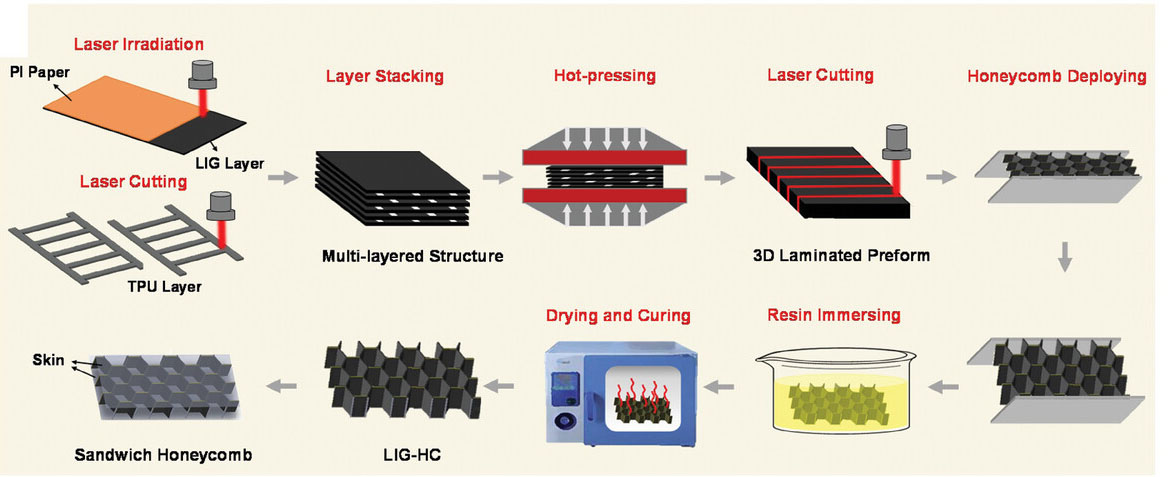| Feb 14, 2024 | |
Laser-induced graphene enables smart sensing honeycombs with multifunctional performance |
|
| (Nanowerk Spotlight) Honeycomb structures have long tantalized engineers with high strength-to-weight ratios perfect for aircraft and satellites. But pristine configurations lack integrated responsiveness to temperature fluctuations, impacts or ice accumulation that cause catastrophic in-flight failures. While previous research explored smart coatings or additive manufacturing, these struggled to balance structural customizability with localized, uniform multifunctionality. | |
| Now, scientists from Beihang University have pioneered a new manufacturing paradigm for responsive honeycombs based on stacking and morphing laser-induced graphene (LIG) layers. Published in Advanced Functional Materials ("Stackable and Deployable Laser-Induced Graphene Layers Toward the Flexible Manufacturing of Smart 3D Honeycombs with Multifunctional Performance"), their customizable approach unlocks real-time electrical, thermal and mechanical sensing unachievable through traditional post-processing. | |
 |
|
| Schematic illustrations for the customized manufacturing process of laser-induced graphene smart honeycombs. (Reprinted with permission by Wiley-VCH Verlag) | |
| The team systematically optimized LIG honeycomb geometry, interface mechanics and resin infiltration to exhibit density-defying load capacity alongside precisely situated dynamic piezoresistive mappings. | |
| As proof-of-concept, they constructed a model aircraft wing able to resist ice accumulation, alert to excessive temperatures, map applied pressures and absorb radar—presaging next-generation vehicles with built-in responsiveness to flight stresses. By rationally harmonizing structure and function with production practicality, this disruptive smart honeycomb technology could accelerate future adoption across challenging aerospace and transport sectors. | |
| Honeycombs are best known for achieving remarkable strength at minimal weight, making them ideal for weight-sensitive applications like aircraft. However, pristine structures lack real-time damage monitoring and response abilities needed to counter threats from turbulence, overheating or ice accumulation. | |
| Prior attempts at smart honeycombs often involved decorating finished products with functional layers or printing hybrid materials. But these struggled with uniform microstructures and precisely localizing sensing regions, while wasting significant materials and time through complex processing. | |
| Instead, the Beihang team creatively stacked and stretched laser-induced graphene (LIG) layers interspersed with thermoplastic ribbons into 3D honeycombs. LIG forms through directly irradiating polymeric films to simultaneously synthesize multifunctional graphene and sculpt bespoke 2D/3D architectures. | |
| Earlier works have tailored LIG’s electrical, thermal and chemical characteristics into wearable sensors or electric generators. But expanding into complex 3D structures like honeycombs presented lingering difficulties with precisely controlling wall thicknesses and achieving uniform, defect-free bonding. | |
| Through systematic optimization, the researchers identified ideal laser parameters for high-quality LIG layers with wrinkled graphene crystals that balanced tensile strength and electrical conductance. They alternated LIG sheets with thermoplastic adhesives in stacked preforms, before compressing under heat to merge interfaces. Preforms were then stretched into customizable honeycombs and stabilized using epoxy resin. | |
| Tuning fabrication metrics enabled honeycomb structures with sizes up to 440 x 433 mm, thicknesses from 3-10 mm and cell lengths ranging 2-5 mm. By adjusting laser patterns or ribbon geometries, the team also demonstrated honeycombs with triangular/rectangular graphene patches and hybrid PI/LIG compositions. Robust structural integrity was assured through interfacing mechanics models with systematic peel/shear tests to guarantee layer bonding against structural distortions. Further resin impregnation allowed modulating density (0.058-0.181 g/cm3), electrical conductivity (0.05-1.34 S/m) and piezoresistivity to tune application performance. | |
| As proof-of-concept, the researchers constructed a model aircraft wing equipped to combat multiple in-flight threats. Its low density enabled floating on water, while high strength supported over 60kg loads. Rapid Joule heating up to 110 °C removed ice buildup or prevented accumulation by elevating surface temperatures. Approaching high heat sources over 1000 °C induced sharp electrical resistance spikes for danger alerts. | |
| Significantly reduced flammability was achieved relative to pure epoxy/PI, with flame-retardant effects linked to graphene interfaces. Static loads on isolated graphene clusters produced location-specific resistance changes, enabling pressure mapping. Dynamic vibration sensing also demonstrated consistent electrical pace-matching from 0.1-5 Hz for turbulence or impact monitoring. | |
| Finally, the wing showcased radar stealth properties below -10dB signal absorption and 37.6dB electromagnetic interference shielding to evade detection. | |
| This smart honeycomb manufacturing technique offers considerable flexibility based on tunable parameters spanning size, thickness, cell geometry, material composition and sensing regions. The researchers have unlocked multifunctional capabilities like temperature control, damage alerting, vibration sensing and radar evasion amenable to next-generation aircraft, satellites, vehicles and sensors. | |
| This streamlined approach avoiding material waste and complex printing holds particular promise for efficiently integrating structurally customizable honeycombs with real-time responsiveness. And with further chemical or genetic functionalization, more exotic electrical, chemical or biological sensitivities could augment utility across diverse dynamic engineering systems. | |
 By
Michael
Berger
– Michael is author of three books by the Royal Society of Chemistry:
Nano-Society: Pushing the Boundaries of Technology,
Nanotechnology: The Future is Tiny, and
Nanoengineering: The Skills and Tools Making Technology Invisible
Copyright ©
Nanowerk LLC
By
Michael
Berger
– Michael is author of three books by the Royal Society of Chemistry:
Nano-Society: Pushing the Boundaries of Technology,
Nanotechnology: The Future is Tiny, and
Nanoengineering: The Skills and Tools Making Technology Invisible
Copyright ©
Nanowerk LLC
|
|
|
Become a Spotlight guest author! Join our large and growing group of guest contributors. Have you just published a scientific paper or have other exciting developments to share with the nanotechnology community? Here is how to publish on nanowerk.com. |
|
